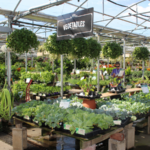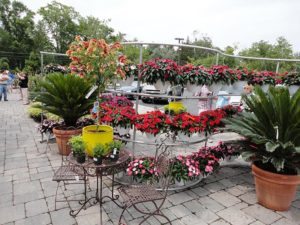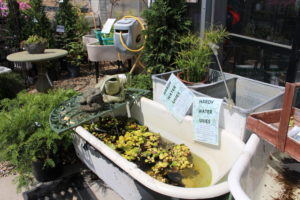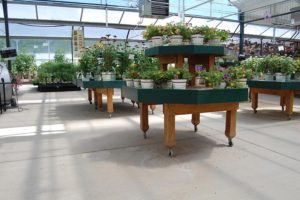Squeezed at Both Ends
The financial collapse has had a major impact on our consumers in many different ways. First, there’s the higher costs they’re experiencing in their necessity purchases such as heating fuel, food, gas in the tank and their never-declining medical expenses. Yes, the cost of a barrel of oil has dropped significantly because of reduced demand from both individuals and manufacturers, but the consumer hasn’t yet seen commensurate reductions. The net effect is reduced spending power because real wages aren’t keeping pace with the inflationary cost increases.
And the reduction in driving translates into fewer shopping trips by the consumer, with more one-stop shopping that benefits the big box retailers rather than visits to specialty destinations retailers such as independent garden centers.
October’s crash in the stock market, with stock valuations dropping by a third almost overnight, has had numerous ramifications on consumers. Those on fixed incomes, such as the retiring boomers, have had to tighten their spending belts as they saw their 401K funds shrink, meaning that they will think twice about buying nonessential products. And consumer confidence is shattered; no one feels safe about job security or how much more their investments will drop. Many families have seen their retirement nest eggs and college savings depleted, and they’ll have to start saving more to replace these losses. Consumer access to credit is being curtailed, and new standards will make it more difficult for them to obtain credit and loans.
Economists are now saying that a recession will most likely occur within the next quarter. (Yes, the past nine months of poor financial performance were just an ugly prelude to the recession we’re about to face.) And unlike recessionary periods of the past, this one and the financial industry’s problems is global in nature, not just isolated to the U.S. economy. Some economic pundits are saying we won’t see the start of a significant recovery until late 2009 or early 2010.
What the Wise Have Done
Those of you who reacted prudently and intelligently have taken many of the right steps to weather the reduction in sales traffic and volume. You’ve reduced your back office expenses, managed your payroll and made adjustments to match staffing to sales, looked at ways to increase productivity and controlled your inventories to keep it turning. The changes you made were transparent to your customers, and you’ve increased your relationships, especially with your most important customers. You’ve focused on staying top of mind by maintaining your advertising exposure and increasing your use of e-newsletters and other targeted marketing methods.
Yes, sales are challenged, but many of you have made the hard changes to maintain some semblance of profitability that will serve you well when the economy and consumer spending turn around. And there’s still business to be had; you just have to be more aggressive to get it.
The Working Capital Challenge
But the financial meltdown is bringing a more insidious challenge to both retailers and growers. The sub-prime debacle has strapped many banks and other investment groups with “bad paper,” and even the banks are having difficulty getting access to capital. Many banks are becoming more risk averse, meaning they are becoming more reluctant to lend money.
Because lawn and garden retailers and growers are largely seasonal businesses, most need an influx of working capital to purchase inputs and inventory to build for the seasonal peaks. The current financial crisis is making it more difficult for companies in our industry to access loans for the working capital necessary to operate.
To obtain these loans, you’ve had to pledge your assets as collateral security. For retailers, the most valuable assets are your land and buildings, if you own them outright (leases are regularly not being counted as an asset by the banks today). For growers, it’s your land. But both commercial real estate and land have become devalued in the current market environment, which means you have less to offer as security. The second most valuable asset has been your accounts receivable, but these too are being discounted by the banking industry for fear that many of these receivables will be uncollectable. And many banks today will not accept perishable product as an asset to secure loans; they believe that in today’s financial environment, some of the inventory may never leave the bench and generate cash flow for you.
In my opinion, many small- to medium-size businesses, not only in our industry, but in all industries, have made the necessary changes to survive the slower sales, but the bigger challenge they face will be access to working capital that will allow them to continue funding their businesses. I believe that companies and their viability will be more affected by the lack of working capital availability than by the lack of sales.
It used to be that you had a long relationship with one bank and you had little problem getting a loan for working capital. Or you went to two or three banks, playing one against the other, and then chose the one that offered you the best terms. But I’ve recently heard from retailers and growers that they’ve been forced to go to as many as 10 different banks to find even one willing to talk to them and consider lending to them. And even then, they weren’t able to get all the capital they needed because their assets had been devalued. Lenders are asking harder questions, looking for more guarantees than ever before and watching their investments more closely on a more frequent basis to make sure the promises and plans you made to them are being met.
Rolling with the Punches
So what can you do to improve your odds of getting the working capital you need to keep your business afloat? First, remember that cash flow is paramount: Manage your costs, expenses and inventory as close to sales trends as possible. Next, make sure you have a realistic business plan that reflects today’s trends and the short- and long-term actions needed to address these trends. Make sure you have different scenarios built into the plan, with both downside and upside situations. Third, work frequently with your accountant and make him party to your all of your business plans; he’s in a great position to provide guidance in these challenging times. Sit down with him monthly and review all of the financial reports, and use this information to make continual changes to adapt to the changing sales and cash flow positions. And finally, if you already have a banking relationship or find one that is willing to work with you, treat them as partners in your business, keeping them regularly informed of your performance vis-a-vis the plan you provided to them. Springing surprises on your lender is a fast way to destroy a relationship and will make it more difficult to maintain a continuous flow of working capital.
It’s true that the customer is still the king; without them, you have no sales. But without access to the working capital you need, you won’t be able to provide customers with what it takes to keep them. The business playing field today is much different than it has been, and the changed consumer behaviors and policies of your lenders will be more permanent than transient. The days of easy credit are over for both consumers and businesses. But realistic planning and laser-focused execution will help mitigate your being squeezed at both ends…


















 Videos
Videos





